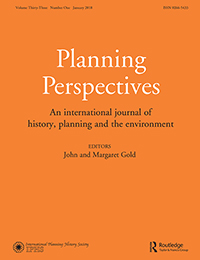This is the sixth in an ongoing series of profiles of GUHP members' work, highlighting the sheer breadth of scholarship in the field of global urban history.
Please consider ordering these titles for your personal and university libraries.
The series also salutes the work of networks and associations whose missions
overlap that of GUHP in significant ways.
Membership in GUHP is free of charge. To join visit our Homepage |
|
|
Just Out The Routledge Handbook of Planning History
Edited by Carola Hein, Architecture,
Delft University of Technology (Netherlands)
(Routledge, 2017)
The Routledge Handbook of Planning History offers a comprehensive interdisciplinary overview of planning history since its emergence in the late 19th century, investigating the history of the discipline, its core writings, key people, institutions, vehicles, education, and practice. Combining theoretical, methodological, historical, comparative, and global approaches to planning history, The Routledge Handbook of Planning History explores the state of the discipline, its achievements and shortcomings, and its future challenges. [more]
GUHP profile, Editor website
In addition to the work of Carola Hein, note contributions by GUHP members Nancy Kwak, Michael E. Smith, John and Margaret Gold, Russ Lopez, Dirk Schubert, Peter Larkham, Dieter Schott, Christopher Silver, and Eugenie Birch
|
| |
|
|
| |
|
Brand New Policing Transnational Protest: Liberal Imperialism and the Surveillance of Anticolonialists in Europe, 1905-1945
by Daniel Brückenhaus, History, Beloit (USA)
(Oxford, 2017)
Policing Transnational Protest offers an original perspective on the history of police surveillance of anticolonial activists in France, Britain, and Germany in the first half of the twentieth century. Tracing the undertakings of anticolonial activists from Asia, Africa, and the Middle East in European cities and reconstructing the reaction of European governments, it illuminates the increasing cooperation of the police and secret services to monitor the activities of the "oriental revolutionaries" and curb their room to maneuver. But those efforts had an unintended inflammatory effect, provoking both supporters and opponents of colonial rule to understand this conflict in increasingly global and trans-imperial terms. [more]
GUHP profile, Author website
|
| |
|
|
|
|
"The assassination of Eduardo Mondlane: FRELIMO, Tanzania, and the politics of exile in Dar es Salaam" in Cold War History
by George Roberts, History, Warwick (UK)
Vol. 11, no. 1, Nov 2016, 1-19
This article, which is a sample from a longer monograph in preparation, uses the city of Dar es Salaam as an urban lens for understanding the politics of FRELIMO in exile and the assassination of its first president, Eduardo Mondlane, in 1969. By adopting a multiarchival technique, these narratives can be broken down to a micropolitical level, shedding light on the distribution of agency in the confluence of superpower rivalry and decolonisation in the Third World. The splits within the liberation movement can be explained via the intersection of internal disagreements, Cold War dynamics, and relations with the Tanzanian state, within the context of Dar es Salaam’s cosmopolitan public sphere. [more]
GUHP profile, Author website
|
|
|
|
|
 |
|
| |
| |
|
Advanced Online Publication “South African ‘Know-How’ and Israeli ‘Facts of Life’: The Planning of Afridar, Ashkelon, 1949-56” in Planning Perspectives
by Ayala Levin, Art History, Northwestern (USA)
Forthcoming 2018
In 1949, in the newly founded state of Israel, South African architects Norman Hanson and Roy Kantorowich planned the city of Ashkelon and, within it, the exclusive neighbourhood unit Afridar. Managed by the South African Jewish Appeal, which initiated and funded the project, Afridar presented a radical exception to Israel’s centralized planning approach during that period. An early example of a semi-private settlement initiative for an ethnic and class-based enclave reserved for ‘Anglo-Saxon’ Jewish immigrants, it functioned as a ‘model town’ for the immigrant population from the Middle East and North Africa, which was housed by the government in the rest of the city of Ashkelon. Afridar’s enclave reproduced planning practices from South Africa, which had been coloured by race since the 1920s. Despite its exclusive image, it was modelled after progressive experiments in the design of Native Townships. Their main objective of such experiments was to improve the standards of housing of racially discriminated populations yet, in practice, they served as a tool to implement apartheid policies. This paper interrogates this ambivalence of social aspirations and complicity with state segregation practices through examining the translation of apartheid’s planning practices to the Israeli context, and the negotiations and conflicts this translation entailed. [Full text online]
GUHP profile, Author website
|
|
|
|
|
|
The Urban China Research Network
The Urban China Research Network (UCRN) promotes multidisciplinary research through international conferences, exchanges of faculty and students, establishment of working groups, and seed funding for new projects. Network members are at work on research projects ranging from urban morphology to the dynamics of rural-urban migration to issues concerning housing, crime and changing family structure within China. [more]
|
|
|
|
To read back-issues of “Noteworthy in Global Urban History,” please click here.
|
| |